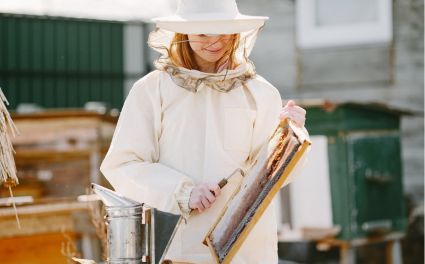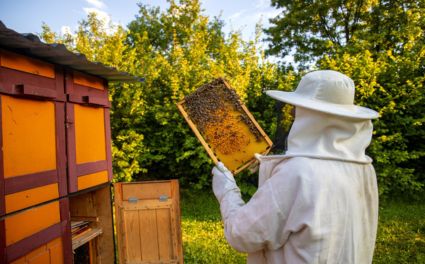Bee nests and wasp nests are two of nature’s most fascinating architectural wonders. While both insects play vital roles in maintaining ecological balance, the way they build their homes, organize their colonies, and interact with their surroundings differs significantly. Understanding these differences not only deepens our appreciation for these pollinators and predators but also helps beekeepers and nature lovers better recognize and respect these tiny engineers of the wild.
🏠 Bee Nest: Structure, Design & Function
A bee nest, often called a beehive, is one of the most sophisticated natural constructions in the insect world. Whether built in the hollow of a tree, a rock cavity, or a man-made hive box, a bee nest is an organized masterpiece of hexagonal wax cells. These cells form vertical combs with small spaces between them, allowing bees to move easily throughout the hive.
Bees also use a sticky resin known as propolis—collected from tree buds—to seal small gaps and reinforce the hive walls. This layer acts as insulation, protecting the colony from cold, predators, and infections while maintaining an ideal internal temperature for honey production and brood development.
If you’re a beekeeper inspecting a hive, wearing protective gear such as beekeeping jackets or beekeeping suits ensures safety and comfort during hive checks.
🧩 Components of a Bee Nest
The bee nest mainly consists of combs and cells, each designed with a purpose:
-
Smaller cells: Used to raise worker bees.
-
Larger cells: Dedicated to drone bees and honey storage.
-
Special queen cells: Built when the colony is preparing to raise a new queen.
Worker bees continuously maintain these cells — cleaning, repairing, and filling them with honey or pollen. These combs form the foundation of colony life.
🍯 Honey Storage and Larval Development
One of the key functions of a bee nest is storing honey, the colony’s primary energy source. Worker bees gather nectar from flowers, transform it into honey through enzymatic activity, and store it in sealed wax cells. This stored honey sustains the colony through harsh weather and food shortages.
The same combs also serve as nurseries. The queen bee lays her eggs in cells, and larvae are nurtured by worker bees with a mix of pollen and royal jelly until they develop into adult honey bees.
For those passionate about learning the Lives of Bees and their complex lifecycle, understanding the nest structure is essential.
(Also read: Why do bees make honey?)

🪶 Wasp Nest: Design, Materials & Construction
In contrast, wasp nests display a completely different engineering philosophy. Depending on the species, wasps build open, umbrella-shaped nests (like paper wasps), fully enclosed football-shaped nests (like hornets), or mud nests (like mud daubers).
Paper wasps use chewed wood fibers mixed with saliva to create a paper-like material. The result is a lightweight, layered structure that’s both strong and flexible. Hornets and yellowjackets take this to the next level by building multi-layered nests with internal chambers and protective outer shells.
Mud daubers, on the other hand, build cylindrical mud nests attached to sheltered surfaces like walls or ceilings — each cell housing one larva and stored prey.
When inspecting or removing wasp nests, safety is critical. Even though bee suits can protect against some wasp stings, wasps are more aggressive and can sting repeatedly. That’s why professionals often use beekeeping gloves and beekeeping veils for extra protection.
🧱 Materials and Chambers in a Wasp Nest
-
Paper wasps: Build with a pulp of wood and saliva, resulting in open combs.
-
Hornets: Construct layered paper-like nests with protective envelopes.
-
Mud daubers: Create tubular mud structures, often arranged side by side.
Each wasp nest features chambers where larvae develop and cells for storing prey or nectar. The queen starts the nest, lays eggs, and worker wasps expand it as the colony grows.
⚒️ Architectural Differences: Bee Nest vs Wasp Nest
The difference between a beehive and a wasp nest lies not just in material but also in design philosophy:
| Feature | Bee Nest | Wasp Nest |
|---|---|---|
| Material | Beeswax & Propolis | Wood pulp, plant fibers, or mud |
| Shape | Vertical hexagonal combs | Open or enclosed papery structures |
| Purpose | Honey storage, brood rearing | Larval rearing, food storage |
| Location | Tree hollows, rock crevices, man-made hives | Under eaves, trees, soil cavities |
| Behavior | Pollinators; less aggressive | Predators; more defensive |
Bees prefer well-sheltered, stable environments — which is why beekeepers use beekeeping suits for kids and adults when inspecting hives. Wasps, however, often build in open areas and can adapt to urban spaces, sometimes becoming a nuisance around human homes.
If you ever mistake a beehive or wasp nest, remember: bees are generally docile pollinators, while wasps are hunters and scavengers. Distinguishing them can prevent unnecessary harm to beneficial honey bees.
🌍 Ecological Importance
Both bee and wasp nests play critical roles in maintaining ecological balance.
🐝 Bee Nests: Pollination & Biodiversity
Bee nests are the foundation of pollination networks. As bees travel between flowers, they facilitate plant reproduction, contributing to the growth of crops, trees, and wild plants. This supports biodiversity and stabilizes ecosystems.
Honey bees also produce honey and beeswax — essential natural resources for humans and wildlife alike. You can learn more about their vital role in the environment in Learn Beekeeping articles on the OZ Armour blog.
🐝 Wasps: Pest Control & Decomposition
Wasps, although often feared, are natural pest controllers. Many species prey on caterpillars, flies, and other insects that damage crops. By feeding their larvae with captured insects, wasps maintain healthy population balances in the ecosystem.
Wasps also aid nutrient recycling, breaking down organic matter and returning it to the soil — another reason their nests are essential to nature.
🧤 Protection Gear for Handling Bees and Wasps
Beekeepers and researchers frequently interact with bees and sometimes encounter wasps. Proper protective equipment is therefore crucial. High-quality beekeeping gloves, beekeeping veils, and beekeeping trousers can safeguard against stings while ensuring flexibility and comfort.
Brands like OZ Armour are well-known among professionals for offering durable beekeeping suits and even pink bee suits that combine safety with style.
For younger enthusiasts or educational programs, beekeeping kids suits ensure safety without restricting movement. Similarly, beekeeping ankle protection is particularly useful in areas where wasps or ground-nesting bees are common.
(Related read: Do Bee Suits Protect from Wasps?)
🐝 Bee Nest or Wasp Nest? How to Identify Safely
When you encounter a nest, observe shape and behavior before approaching:
-
Bees enter and exit slowly, often in a consistent pattern.
-
Wasps move quickly, guarding their nest aggressively.
-
Bee nests are waxy and enclosed; wasp nests look papery or muddy.
If you’re unsure, keep a safe distance. Removing a bee nest requires contacting a beekeeper, while wasp nest removal should be left to pest control professionals wearing proper beekeeping equipment.
Never attempt to disturb a colony without full protection. In case of stings, follow guides like Safely Remove a Bee Stinger for quick first aid.
🌿 Ecological Harmony Between Bees and Wasps
Despite their differences, bees and wasps complement each other’s roles in nature. Bees support plant life through pollination, while wasps regulate insect populations. Together, their nests reflect a delicate balance — one that sustains forests, gardens, and farms.
Just as bumblebee vs honeybee comparisons reveal evolutionary adaptations, exploring bumblebee vs carpenter bee highlights their ecological diversity.

🧠 Final Thoughts
Bee nests and wasp nests may differ in materials, architecture, and colony behavior, but both represent the ingenuity of nature’s design. Bees build symmetrical wax combs that nurture the honey bees we depend on for pollination and honey production. Wasps craft versatile papery or muddy nests that house efficient pest controllers.
For beekeepers and enthusiasts, studying these nests not only deepens appreciation for these insects but also reinforces the need for proper protective gear and sustainable beekeeping practices.
To explore more insights and expert tips, visit Read More Blogs About Beekeeping or dive into Learn Beekeeping resources. You can also discover premium tools and apparel in the Beekeeping Equipments section of OZ Armour — trusted by professionals worldwide for safe and sustainable beekeeping.



